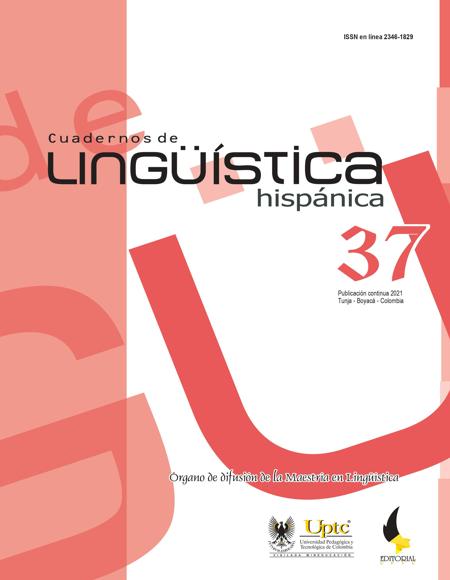The subjunctive in spanish and italian: a contrastive description

Abstract
In the Spanish-speaking and Italian-speaking linguistic panorama, the subjunctive has been defined mainly from a structural perspective based on the notion of syntactic dependency. From the 19th century became relevant the
semantic approach, and the notions of reality / unreality began to predominate in the definition of mode. However, many bibliographic sources such as Vásquez (2013), Stewart (2002) and Haverkate (2002), have revealed that the use of the subjunctive is not only limited to the appearance of a modalizer of possibility, imaginary, or potential fact, but that the intention of the speaker and
the presence of inducers without any unreality value can introduce inexplicable forms of the subjunctive from a perspective purely semantic or clearly syntactic. The objective of this paper is to identify the main distributions of the subjunctive in Spanish and Italian. Contrastive, exploratory, descriptive, and documentary analysis is limited to epistemic and deontic completive propositions, relative sentences and adverbial subordinate clauses, given space limitations.
Keywords
Subjuntivo, español, italiano
References
- Battaglia, S.& Pernicone, V. (1980). La grammatica italiana. Loescher.
- Belletti A. (2001). Funzioni delle frasi subordinate: Comparative, In A. Cardinaletti, L.
- Renzi, & G. Salvi, Grande Grammatica Italiana di Consultazione (pp. 832-853). Il Mulino.
- Bello, A. (1857). Gramática de la lengua castellana destinada al uso de los americanos. (4.a ed.). Echeverry Hermanos.
- Bermejo, F. (2008). Le subordinate avverbiali: Uno studio contrastivo spagnoloitaliano. Bononia University Press.
- Bermejo, F. (2009). Le relative spagnole e italiane. Celid.
- Berruto, G. (1987), Sociolinguistica dell’italiano contemporaneo. Carocci.
- Berruto, G. (2010). Italiano standard. Enciclopedia dell’italiano Treccani.
- Bertucelli, M. (2001) Funzioni delle frasi subordinate: Finali, , In A. Cardinaletti, L.
- R enzi, & G. Salvi, Grande Grammatica Italiana di Consultazione (pp. 818- 825). Il Mulino.
- Bustos, A. (1974) A syntactic correlate of semantic and pragmatic relations: The subjunctive mood in Spanish. University of Illinois.
- Bustos, E. (1986). Pragmática del español: negación, cuantificación y modo. Universidad Nacional de Educación a Larga Distancia.
- Franklin Yessid Arias Bedoya Cuadernos de Lingüística Hispánica n.° 37, 2021. https://doi.org/10.19053/0121053X.n37.2021.12798 DOI: https://doi.org/10.19053/0121053X.n37.2021.12798
- Cravens, T., & Lunn, P. (1991). A contextual reconsideration of the Spanishra “indicative”. In S. Fleischman, & L. Waugh, Discourse Pragmatics and The Verb. Routledge.
- Cueva, A. (2018). Aproximación al modo subjuntivo del español desde una perspectiva multivariable. Folios, (48), 73-84. DOI: https://doi.org/10.17227/folios.48-8136
- Dardano, M., Trifone, P. (1988). La lingua italiana. Zanichelli.
- Falcinelli, A. (2015). Modalidad epistémica y adverbios de duda: el caso de magari en italiano. Linguae, 14(2), 29-46. DOI: https://doi.org/10.7358/ling-2015-002-falc
- Fogarasi, M. (1983). Grammatica italiana del Novecento. Bulzoni.
- Fornaciari, R. (1879). Grammatica della lingua italiana. Sansoni.
- Giannakidou, A. (2009). The Dependency of the Subjunctive Revisited: Temporal Semantics and Polarity. Lingua, 119, 1883-1908. http://home.uchicago. edu/~giannaki/pubs/LinguaMood2009.final.pdf DOI: https://doi.org/10.1016/j.lingua.2008.11.007
- Gielau, A. (2015). Mood Distribution and the CP Domain ff Subjunctive Clauses in Spanish. (PhD thesis), University of Iowa. https://doi.org/10.17077/etd. bpl4g56e
- Gili, G. (1980). Curso superior de sintaxis española. Bibliograf.
- Giorgi, A. (2009). Toward A Syntax of the Subjunctive Mood. Lingua, 119(12), 1837- 1858. DOI: https://doi.org/10.1016/j.lingua.2008.11.008
- Giusti, G. (2001). Frasi avverbiali: temporali, causali e consecutive. In A. Cardinaletti,
- L. Renzi, & S. Giampaolo, Grande Grammatica Italiana di Consultazione (pp. 720-784). Il Mulino.
- Haverkate, H. (2002). The Syntax, Semantics and Pragmatics of Spanish Mood (Pragmatics & Beyond New Series). John Benjamins Publishing. DOI: https://doi.org/10.1075/pbns.96
- Lenz, R. (1920). La oración y sus partes. Centro de Estudios Históricos, Junta para la Ampliación de Estudios e Investigaciones Científicas, RFE.
- Pérez, M. (1999). El modo en las subordinadas relativas y adverbiales. En I. Bosque & V. Demonte (dirs.), Gramática descriptiva de la lengua española. Vol. 2 (pp.3253-3322). Espasa Calpe.
- Prandi, M. (1996). La subordinazione non completiva. Un frammento di grammatica filosofica. Studi Italiani di Linguistica Teorica e Applicata, 25, 1. Real Academia Española -RAE-. (2009). Nueva gramática de la lengua española. ESPASA.
- Real Academia Española -RAE-. (2010). Manual de la nueva gramática de la lengua española. ESPASA.
- Ridruejo, E. (1999). Modo y modalidad. El modo en las subordinadas sustantivas. En I. Bosque & V. Demonte (dirs.), Gramática descriptiva de la lengua española. Vol. 2 (pp. 3209-3251). Espasa Calpe.
- Rojo, G. (1976). La correlación temporal. Verba, (3), 65-89.
- Sabatini, F. (1985). L’italiano dell’uso medio: una realtà tra le varietà linguistiche italiane, En: Geschichte und Gegenwart, hrsg. von Günter Holtus, Edgar Radtke (dirs.), Gesprochenes Italienisch. pp. 154-185. Tübingen, Narr.
- Salvá, V. (1835). Gramática de la lengua castellana según ahora se habla. Librería de los SS.
- Sensini, M. (1990). La grammatica della lingua italiana. Mondadori.
- Serianni, L. & Antonelli, G. (2011). Manuale di linguistica italiana: storia, attualità, grammatica. Pearson.
- Sorrento, L. (1951). Sintassi romanza. Istituto Editoriale Cisalpino.
- Stewart D. (2002): Il congiuntivo italiano: modo della realtà? Uno sguardo al congiuntivo nelle grammatiche italiane moderne, in L. Schena, M. Prandi.
- M. Mazzoleni (a cura di), Intorno al congiuntivo: storia, tipologia, traduzione, Bologna: CLUEB, p. 105-122. - ISBN: 8849118821.
- Vanelli, L. (2001). La concordanza dei tempi. In A. Cardinaletti, L. Renzi, & S.
- Giampaolo, Grande Grammatica Italiana di Consultazione (pp. 611- 632). Il Mulino.
- Vásquez, J. (2013). Los modos verbales del español actual. Lingüística y Literatura, 255 -271.
- Wandruszka, U. (2001). Frasi subordinate al congiuntivo. In A. Cardinaletti, L.
- Renzi, & G. Salvi, Grande Grammatica Italiana di Consultazione (pp. 415-481). Il Mulino.
- Zambaldi, F. (1905). Grammatica della lingua italiana. Sonzogno